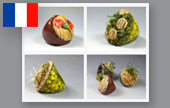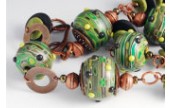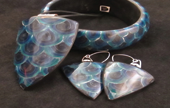More Classes by this Instructor
Other Polymer Clay Classes
Your Recently Viewed Classes
Learn More About this Class
- ... materials
-
Class Materials List
Faux Wood
• a pasta machine
• Polymer clay - 2 oz packages :
• 1 white
• 1 translucent
• 3/8 + 3/8 brown
• 1/16 yellow
• a nut of black of Kato polyclay or any other stiff clay of your choice
• rigid blade and a scalpel
• oil paint in burnt sienna" or "burnt umber" or any other shade of brown
• a compass, a ruler, a pencil, scissors, a felt pen and paper
• 1 round or oval cutter type Kemper cutter
• baking soda (for baking) •
• A round cookie cutter set (to make curved shapes)Faux Pebbles and Stones
• a pasta machineFor the beach pebbles :
• 1 package of translucent clay
• 1/8 of brown clay
• 1 pinch of white and black clay
• brown oil paint (the shade depends on the color you want for your pebbles)
• liquid polymer clay
• a piece of plasterer's gridFor the black stones :
• 1 package of black clay
• a nut of grey (scrap clay mixed to a grey shade) and a nut of light brown
• a small grater
• liquid polymer clay
• sanding blocks coarse and medium grit and sanding paper #400 and #600 or the 1500 and 1800 sheets from a micro-mesh sanding kit.Bracelet
• 7 Faux pebbles, one of which has to be very small
• 3 faux wood pieces one of which has to be opened to be used as a clasp
• 35 inches of round leather cord
• a mini drill
• CA glue
- ... instructors
-
Sylvie Peraud
Making jewelry has been part of Sylvie’s hobbies since childhood. Beads when she was young, melted recycled plastics later and polymer clay since 2005. Inspiration is everywhere around her, when walking in the nature, when discovering other art mediums, when reading a book. What she loves best is making faux: faux wood and faux stones. The closer she gets to the real material, the happier she is. Working with a medium as versatile as polymer clay makes it endless.
When working with polymer clay, there are no limits other than those you fix to yourself. It has led Sylvie to create a simple...
Read more - ... FAQ
-
Frequently Asked Questions
If you cannot find the answer you are looking for in your FAQ, please contact us on [email protected]
I am having problems viewing the classes. Any suggestions?
The classes should play fine across all common browsers and operating systems. The only technical requirement is a fairly recent version of the Adobe Flash Player. You can download the latest player for free at http://get.adobe.com/flashplayer/ . For best possible viewing experience, we recommend above average Internet connections.
If you are experiencing problems such as delays, chopping, freezing or browser crashing, please make sure that you have the latest flash version and are on a stable and fairly good connection. It will also very often help to empty your browser cache.
If you are on a recent flash version, with a good connection, have emptied your cache and still have problems viewing the class, please contact us!
For how long can I access my courses?
Forever. Your access to your CraftArtEdu classes never expires. You can watch them anytime and as many times you would like.
How do I access the class after purchasing it?
Your class is available to view from your account under “My Account."
I am having problems accessing the class handout.
The class handouts are PDF's If there is an instructor hand out for your class, it will be in your account on the View Class page link under Material Links.
After taking a class, are you then allowed to use the technique to produce pieces to sell, as long as you reference that it was a technique learned from whoever taught the class?
"Yes, students can produce work to sell - teachers know that they are putting techniques out there for their students to use. The hope is that the student will apply techniques to create their own unique spin on them, but we cannot take money from students and then say "you can't do that." We do ask that they give credit to the originator." - Donna Kato
Can I become a CraftArtEdu Instuctor?
We are always looking for great instructors. If you are interested in teaching, please send us an email: [email protected] with a description of the media you would like to teach as well as your bio and a link to your website.
- ... reviews






